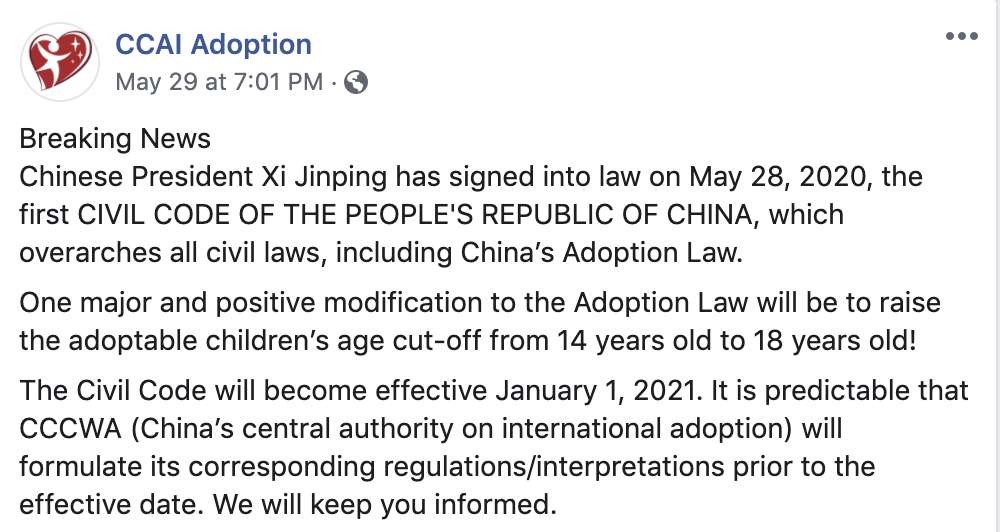
Is the China program a good option if I want to adopt a young girl with minor needs?
That is the question continually being asked both by those seeking to adopt for the first time and those who adopted previously from China. Unfortunately, there is no easy yes or no answer. Since we do have shared list data from the past three years, there is some information to help with that decision. But please keep in mind that this is only my opinion and speculation.
Starting in December 2019, the CCCWA has done a trial method of matching LID files. Each agency can put forward one family per LID file. Out of those families, the one with the earlier LID date will receive the file. My understanding is that in both December and January all of the files were matched with European families. Because European countries have more restrictive laws governing international adoption, European families were at a disadvantage at being matched with LID files from the shared list. There are European families who have been waiting five years or longer. In comparison, few American families have waited longer than 2 years from dossier log in to be matched. So until the European back log gets cleared out they will presumably continue to be matched with new LID files until they get caught up to dossier dates that are shared with American families.
Previously, if you were starting the process looking at the number of waiting families would be important because the fewer families an agency has ahead of you the sooner it will be your turn. However, assuming LID files continue to be matched by dossier date, this puts you into the greater pool of families with dossiers logged in at the CCCWA, not just the pool of families at your agency. I don’t know how many dossiers there are for the special needs program at the CCCWA. There are 70+ agencies with a China program worldwide. The largest American agency has at least 100, if not 200, LID families. We could put the next few most popular agencies at say, 30 dossiers each, and all the other agencies at a dozen or less. I’m going to use 1000 dossiers as a very general number to work with because it’s nice and round.
So, if you are dossier #1001 when would you be matched with that young girl with minor needs? The number of girl LID files increased from 2018 to 2019, but I don’t want to assume that will keep up. I think we should use 100 girl LID files per year as our number there. That means it could be ten years before you are matched. If you think that is crazy talk, remember that families which sent a dossier through the standard (non-special needs) program in early February 2007 waited eleven years to be matched. And a lot of February 2007 is still waiting.
However, not all 1000 of those families ahead of you are waiting for young girls with minor needs. It’s important to remember that LID versus special focus is a rather arbitrary designation that reflects the most popular needs. A lot of families talk about “going the LID route” but this isn’t a system where you have to pick an option. Many families will be matched with special focus files either before or after their dossier is logged in at the CCCWA because their agency found a special focus file which was a good fit for the family. For this reason, I think it is still a good idea to ask about the number of waiting families at an agency before making your agency decision. Don’t assume you will only be looking at LID files. In an agency with fewer waiting families, you very well might be matched much sooner with a special focus child which is perfect for your family.
Let’s say that 500 of the dossiers ahead of you are matched with special focus children. That brings your potential wait down to five years. If half of the remaining 500 dossiers are open to boys, your wait might be as little as three years. I believe several agencies are now quoting three years as the estimated wait time for a young girl with minor needs. I think 3-5 years is probably more accurate since I wouldn’t assume the number of LID files will keep increasing.
It is accurate to say that the China program is transitioning from young children with minor needs to older children with moderate or greater needs. There are still young children and children with minor needs available but the more flexible you are on your child criteria the faster you will be matched. Because of the increasing matching times for those young children with minor needs, families are beginning to choose other programs. In 2018, there were increases in adoptions from India and Colombia. I think the number of families adopting from China will continue to decrease. When the US Department of State releases the 2019 numbers, I think it’s very possible there will have been under 1000 adoptions from China.
So, should you adopt from China if you will only accept a young girl with minor needs? I can’t say what the future holds and I certainly don’t know what is best for your family. If you are absolutely set on a young girl and only open to a few needs, I think I would look at other adoption options. I can’t stress enough that most months there are 10 or fewer LID girl files, some of which are older girls, but 70+ agencies with hundreds of waiting families. People always want to know why it takes so long. That’s why–supply and demand. There are far more families who want to adopt young girls with minor needs than there are actual girls who need families.
However, for those who are more flexible on age/gender/medical need I think the China program is still a good option. There are more than 3000 children waiting on the shared list who DO need families with no wait necessary. Each of those children deserve a loving family just as much. Maybe one is the child you’ve been waiting for.






